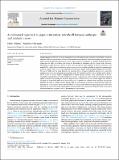Por favor, use este identificador para citar o enlazar a este item:
http://hdl.handle.net/10261/261851COMPARTIR / EXPORTAR:
 SHARE SHARE
 CORE
BASE CORE
BASE
|
|
| Visualizar otros formatos: MARC | Dublin Core | RDF | ORE | MODS | METS | DIDL | DATACITE | |

| Título: | A continental approach to jaguar extirpation: A tradeoff between anthropic and intrinsic causes |
Autor: | Villalva, Pablo CSIC ORCID; Palomares, Francisco CSIC ORCID | Palabras clave: | Human-carnivore coexistence Extinction risk modelling Jaguar Retaliatory hunting |
Fecha de publicación: | 7-feb-2022 | Editor: | Elsevier | Citación: | Journal for Nature Conservation 66 (2022) | Resumen: | Human impacts are blamed for range contraction in several animal species worldwide. Remarkably, carnivores and particularly top predators are threatened by humans despite their key role in maintaining ecosystem balance and functions. Conservation strategies to allow human-carnivore coexistence are urgently needed. These strategies must be built on evidence and driven by knowledge of population risk at a broad scale. However, knowledge on wide distributed species is often based on regional expert opinions in which uncertainty is not quantifiable, making data incomparable across regions. Here we develop a method to assess the endangerment status of a species based on its range contractions and the main threats using the jaguar Panthera onca as model. The use of GLM with the main intrinsic and extrinsic drivers of jaguar extinction allowed us to assess the endangerment status at continental and population scale. We found this method to be a valuable tool to obtain a broad picture of human-induced endangerment in animal species. Intrinsic traits (summarized in the demographic contraction theory) and anthropic traits (based on agriculture, cattle and human densities) explained jaguar extinction highlighting the particular importance of livestock activity. Our results suggest that livestock ranching has a pervasive effect on the species likely due to habitat loss combined with retaliatory hunting. We highlight the need to rethink policies, practice and law enforcement in relation to livestock and suggest the development of action plans based in local evidence in those countries where endangered populations have been detected. We also recommend involving and encouraging land owners and private companies in the conservation of private lands that comprise much of the endangered jaguar range. | Descripción: | Datos complementarios a este artículo se pueden encontrar en línea https://doi.org/10.1016/j.jnc.2022.126145. | Versión del editor: | https://doi.org/10.1016/j.jnc.2022.126145 | URI: | http://hdl.handle.net/10261/261851 | DOI: | 10.1016/j.jnc.2022.126145 | ISSN: | 1617-1381 |
| Aparece en las colecciones: | (EBD) Artículos |
Ficheros en este ítem:
| Fichero | Descripción | Tamaño | Formato | |
|---|---|---|---|---|
| jaguar_extirpation_causes.pdf | Articulo principal | 1,61 MB | Adobe PDF |  Visualizar/Abrir |
CORE Recommender
SCOPUSTM
Citations
6
checked on 22-abr-2024
WEB OF SCIENCETM
Citations
5
checked on 23-feb-2024
Page view(s)
57
checked on 27-abr-2024
Download(s)
71
checked on 27-abr-2024
Google ScholarTM
Check
Altmetric
Altmetric
Este item está licenciado bajo una Licencia Creative Commons

